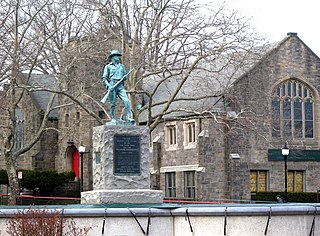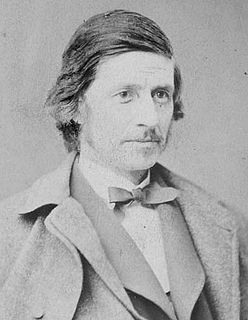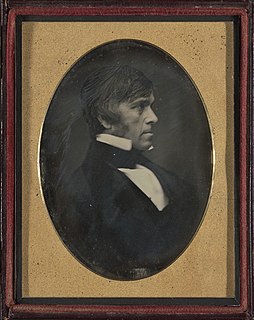| Somers Library | |
|---|---|
| Branch of | Westchester Library System |
| Map | |
 | |
The Somers Library is a member of the Westchester Library System. The present building opened in 1982. It is located in Reis Park off New York State Route 139 in Somers, NY.
| Somers Library | |
|---|---|
| Branch of | Westchester Library System |
| Map | |
 | |
The Somers Library is a member of the Westchester Library System. The present building opened in 1982. It is located in Reis Park off New York State Route 139 in Somers, NY.
The first library in Somers was organized by Ruth Tompkins in 1875. It consisted of a shelf of books on the second floor of District Schoolhouse Number 2. A portion of the books in the original collection came from Ralph Waldo Emerson's private library. [1] Ruth Tomkins' sister Susan had married John Emerson, nephew of Ralph Waldo Emerson and through them Ralph Waldo Emerson, or "Uncle Waldo", became one of the library's first patrons.[ citation needed ]
The reasons for the move are unclear, but in the early 1880s the Library moved to a converted chicken coop across the street from the schoolhouse. It remained at the refurbished chicken coop for 14 years.[ citation needed ]
In 1896, the Library outgrew the chicken coop and moved into a former cobbler's shop. The cobbler's shop location later became the Elephant's Trunk Thrift Shop, which was run by Friends of the Somers Library to provide money for the Library's operation. In 1963, the Library outgrew the cobbler's shop and moved across the street to the former cobbler's house, which was refurbished for the Library's use.[ citation needed ]
The present building is located on a portion of the Wright-Reis Homestead and opened in 1981. [2] In 2022 there are plans to refurbish the building. [1]
Items can be borrowed from the library by members of the Westchester Library System. The library has a reading room that holds newspapers and periodicals. [3] There is also a seed library. [4]
The library is supported by a Friends group. [5]

Ralph Waldo Emerson, who went by his middle name Waldo, was an American essayist, lecturer, philosopher, abolitionist, and poet who led the transcendentalist movement of the mid-19th century. He was seen as a champion of individualism and a prescient critic of the countervailing pressures of society, and his ideology was disseminated through dozens of published essays and more than 1,500 public lectures across the United States.

Mount Vernon is a city in Westchester County, New York, United States. It is an inner suburb of New York City, immediately to the north of the borough of the Bronx. As of the 2020 census, Mount Vernon had a population of 73,893, making it the eighth most populous city in the state (2010).

Bedford is a town in Westchester County, New York, United States. The population was 17,335 at the 2010 census.

Eastchester is a town in southern Westchester County, New York, United States. The population was 32,363 at the 2010 census, and 32,964 as of 2018's census estimates. There are two villages within the town: Bronxville and Tuckahoe. The town contains a census-designated place also named Eastchester, which is the whole town of Eastchester excluding Bronxville and Tuckahoe.

John Murray Forbes was an American railroad magnate, merchant, philanthropist and abolitionist. He was president of both the Michigan Central railroad and the Chicago, Burlington and Quincy Railroad in the 1850s. He kept doing business with Russell & Company.

"Self-Reliance" is an 1841 essay written by American transcendentalist philosopher Ralph Waldo Emerson. It contains the most thorough statement of one of Emerson's recurrent themes: the need for each individual to avoid conformity and false consistency, and follow his own instincts and ideas. It is the source of one of Emerson's most famous quotations:

Ainsworth Rand Spofford was an American journalist and the sixth Librarian of Congress. He served as librarian from 1864 to 1897 under the administration of ten presidents.

Franklin Benjamin Sanborn was an American journalist, teacher, author, reformer, and abolitionist. Sanborn was a social scientist, and a memorialist of American transcendentalism who wrote early biographies of many of the movement's key figures. He founded the American Social Science Association, in 1865, "to treat wisely the great social problems of the day". He was a member of the so-called Secret Six, or "Committee of Six", which funded or helped obtain funding for John Brown's Raid on Harpers Ferry; in fact he introduced Brown to the others.

The Ralph Waldo Emerson House is a house museum located at 18 Cambridge Turnpike, Concord, Massachusetts, and a National Historic Landmark for its associations with American philosopher Ralph Waldo Emerson. He and his family named the home Bush. The museum is open mid-April to mid-October; an admission fee is charged.

Wykagyl is a suburban community in New Rochelle, Westchester County, New York, United States. It is conterminous with ZIP code 10804, encompassing much of the city's 'North End'. According to Forbes, in 2010 Wykagyl's 10804 ZIP code, with a median home price of $806,264, ranked 333rd on its list of the 500 most expensive ZIP codes in the U.S. The Washington Post ranks Wykagyl among the nation's 650 Super Zips, or those with the highest percentile rankings for median household income and the share of adults with college degrees or higher.

The Reuben Brown House is a colonial style house located in Concord, Massachusetts.

The Mayflower House Museum is an 18th-century period historic house museum in Plymouth, Massachusetts operated by The Mayflower Society, also known as the General Society of Mayflower Descendants. The Society purchased the Edward Winslow House in 1941.

The Second Church (1649–1970) in Boston, Massachusetts, was first a Congregational church, and then beginning in 1802, a Unitarian church. The congregation occupied a number of successive locations around town, including North Square, Hanover Street, Copley Square, and the Fenway. Ministers included Michael Powell, Increase Mather, Cotton Mather, and Ralph Waldo Emerson. In 1970 it merged with Boston's First Church.

The transparent eyeball is a philosophical metaphor originated by Ralph Waldo Emerson. The transparent eyeball is a representation of an eye that is absorbent rather than reflective, and therefore takes in all that nature has to offer. Emerson intends that the individual become one with nature, and the transparent eyeball is a tool to do that. In the essay Nature, Emerson explains that the meaning behind the transparent eyeball is similar to a scientific standpoint on the Bible.
Mary Moody Emerson was an American letter writer and diarist. She was known not only as her nephew Ralph Waldo Emerson's "earliest and best teacher", but also as a "spirited and original genius in her own right". Ralph Waldo Emerson considered her presence in his life a “blessing which nothing else in education could supply”; and her vast body of writing—her thousands of letters and journal entries spanning more than fifty years—"became one of Emerson's most important books". Her surviving documents reveal the voice of a "woman who […] had something to say to her contemporaries and who can continue to speak to ours" about "the great truths that were the object of her life's pilgrimage".

Lidian Jackson Emerson was the second wife of American essayist, lecturer, poet and leader of the nineteenth century Transcendentalism movement, Ralph Waldo Emerson, and mother of his four children. An intellectual, she was involved in many social issues of her day, advocating for the abolition of slavery, the rights of women and of Native Americans and the welfare of animals, and campaigned for her famous husband to take a public stand on the causes in which she believed.
Raymond Emerson was an American civil engineer, investment banker, and faculty at the Peabody Museum of Archaeology and Ethnology. He is known for his large donations of personal Ralph Waldo Emerson letters and other documents for educational purposes. He was part of the Emerson family, and was Ralph Waldo Emerson's last surviving grandson. In addition to his marriage to Amelia Forbes, he was also connected to the Forbes family through other marriages in his parents' and his own generations.

Ralph Waldo Trine was an American philosopher, author, and teacher. He wrote many books on the New Thought movement. Trine was a close friend of Henry Ford and had several conversations with him about success in life.
Ralph Leslie Rusk was an American academic and writer. Rusk began teaching at the University of the Philippines during the early 1910s before teaching English at Indiana University from 1915 to 1925. Upon entering Columbia University in 1925, Rusk continued to teach English and remained with the university until he retired in 1954. Apart from academics, Rusk spent the majority of his writing career on works about Ralph Waldo Emerson. Rusk first published The Letters of Ralph Waldo Emerson in 1939 before releasing The Life of Ralph Waldo Emerson in 1949. The following year, The Life of Ralph Waldo Emerson received the 1950 National Book Award for Nonfiction. Rusk was also a recipient of the Guggenheim Fellowship in 1945.

The Carlyle–Emerson correspondence is a series of letters written between Thomas Carlyle (1795–1881) and Ralph Waldo Emerson (1803–1882) from 14 May 1834 to 20 June 1873. It has been called "one of the classic documents of nineteenth-century literature."
Coordinates: 41°18′12″N73°42′51″W / 41.303293°N 73.714236°W